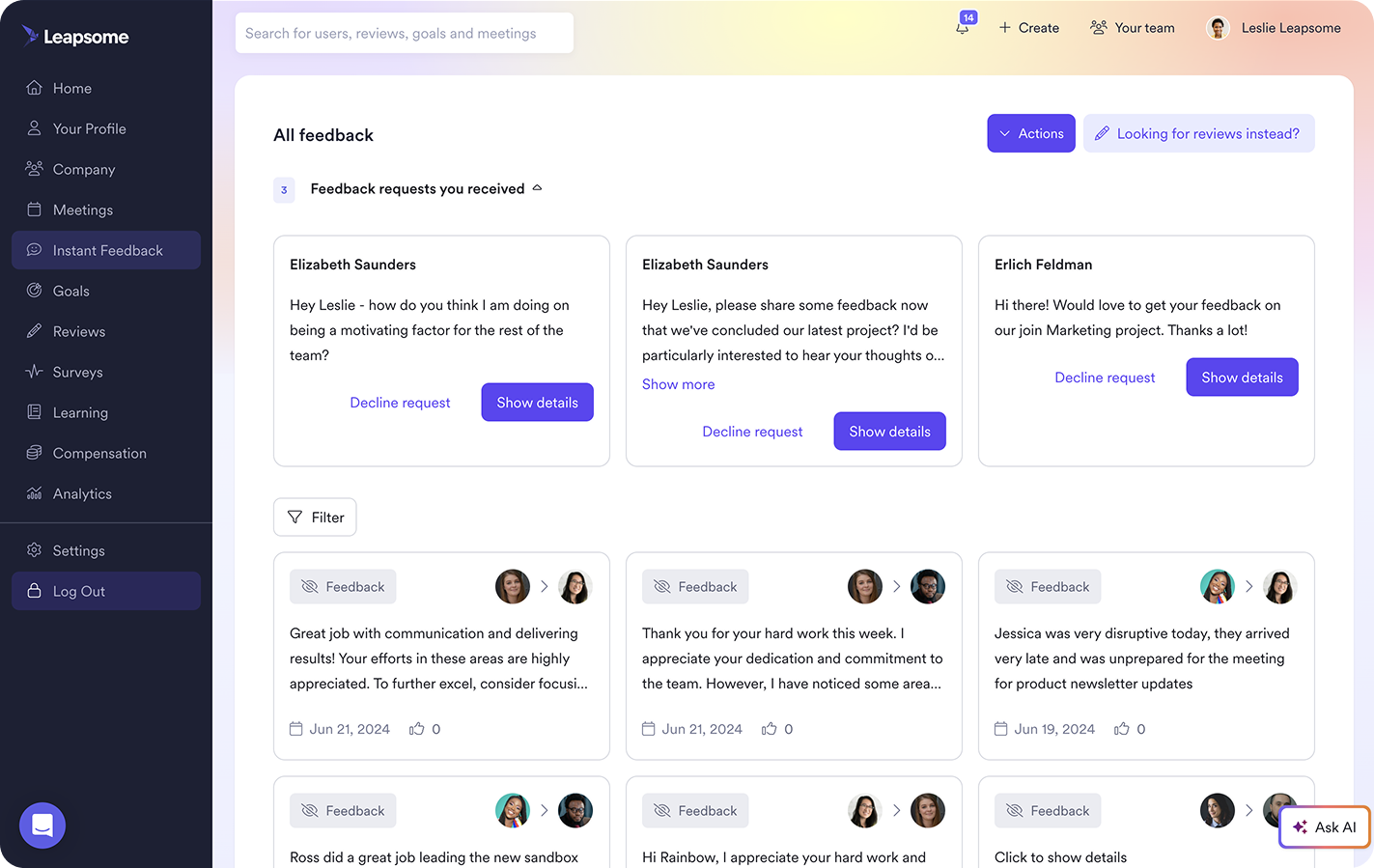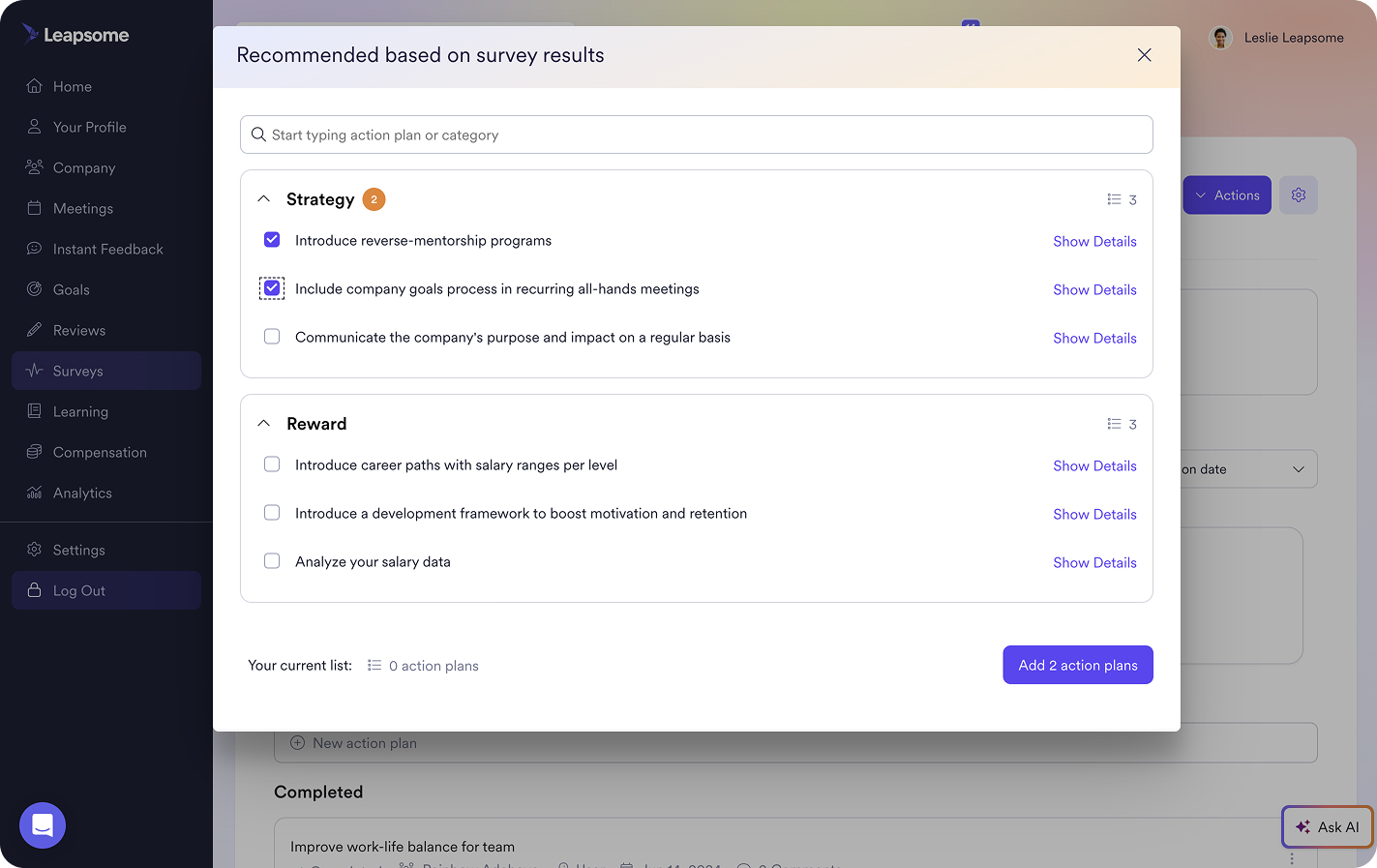Rethinking HR: 8 innovative ways to boost engagement & satisfaction

Employee engagement should encompass more than fancy coffee machines or a plush benefits package. While these perks can make workdays a bit brighter, they don't necessarily nurture the passion and motivation that's at the heart of engagement.
Here's a reality check — a mere 36% of workers surveyed in our 2023 global study reported feeling engaged. (1) This indicates that employers may need to rethink their strategies to find ways to engage employees on a deeper level. Without engaged employees, companies risk decreased productivity rates, lower levels of creativity and innovation, and higher turnover.
Ignoring those potential consequences of low engagement would be a costly mistake — research shows that it costs US$4,700 to replace just one employee. Moreover, if you consider the soft costs associated with hiring and onboarding into account, that figure shoots up to three or four times the employees’ yearly salary in total. (2)
To mitigate this, it’s essential that HR managers and company decision-makers identify opportunities to build more satisfying professional relationships with their employees, fostering a sense of genuine connection, respect, and motivation within their organizations.
In this article, we'll share some concrete employee engagement programs you can implement to develop a sustainable work environment and a motivated, engaged, and resilient team that’s ready to drive your business forward.
- Leapsome’s State of People Enablement Report, 2023
- SHRM, 2022
🦾 Elevate employee engagement with the power of AI
Leapsome Surveys allows you to track engagement trends across different survey rounds and use generative AI to extract key themes and feedback.
👉 Learn more
What can HR do to improve employee engagement?
Research shows that engaged employees are more likely to be involved in and enthusiastic about their work and professional environment. Additionally, a recent analysis by Gallup found that companies with higher engagement levels experienced an astonishing 81% decrease in absenteeism and an 18% drop in turnover rates. They also improved productivity levels by 18% and overall profitability by 23%.
That’s why an employee engagement action plan isn't just a nice to have — the ROI of engagement makes it essential for any proactive HR team. Because when you prioritize your employee engagement programs, you’re cultivating a passionate, motivated community that drives company success. HR professionals are especially well-positioned to take action due to their unique position, people management expertise, and influence on the company culture.
For HR teams wondering where to get started when tackling low employee engagement, the best place to start is by investigating why individuals are leaving the company. This team member data gives excellent insight into where you should invest your time and energy. For example, suppose you see that team members are leaving due to a lack of development opportunities. In that case, you might implement career progression plans and offer more personalized learning and development opportunities.
Alternatively, if you need to improve your approach to employee assessments, create a culture of feedback and streamline your performance review process.
According to our 2023 State of People Enablement Report, some of the top reasons why professionals say they’d leave their company are:
- Poor work-life balance (74%)
- Lack of compensation and benefits (76%)
- Insufficient flexibility (61%)
- Bad performance review processes (77%)
- Little to no development opportunities (21%)
Employee engagement program examples
Effective employee engagement schemes don’t need to be elaborate or exceed your current budgets. In fact, you can build many of them to fit within your recurring processes for communication and collaboration. In doing so, you’ll find your engagement programs are far more sustainable and likely to yield long-term results.
Some creative employee engagement program examples include:
- Implementing more praise and recognition into your communication channels
- Making onboarding more thorough and tailored to team members at different levels
- Creating clear career progression plans for employee development
- Conducting “stay interviews” to discover what drives employee retention
- Building employee resource groups (ERGs) where team members from common backgrounds can share experiences and discuss ways to improve the company culture
8 employee engagement programs HR can implement
Every engagement strategy should start with an employee engagement survey. That way, you’ll get the real-time pulse of your people’s experiences, concerns, and satisfaction levels. If you need a little inspiration to get started, check out our pre-built engagement survey questions. We have a series of quantitative survey templates with closed- and open-ended survey questions to initiate detailed qualitative feedback.
Suppose you use a dedicated people enablement solution like Leapsome to manage your employee engagement schemes. If so, you can access AI-generated survey summaries and personalized action plan recommendations based on your survey results directly within the platform.
Once you have the guidance you need from your survey results, it’s time to turn those insights into action. You can implement our eight employee engagement program ideas to start moving the dial.
1. Recognize great work

When people’s professional efforts are acknowledged and appreciated, they're more likely to feel motivated and committed to their organization. A recent report from Achievers Workforce Institute revealed that increasing the frequency of recognition can increase the likelihood of engagement and productivity by 40% and job commitment by 25%.
One way to make employee recognition an integral part of your employee engagement scheme is with a tool like Leapsome’s Praise Wall — a virtual bulletin board where team members can publicly celebrate each other’s accomplishments. For instance, someone might recognize a coworker who went the extra mile on a recent project or share a shoutout for a team member who always lends a helping hand.
This feedback is also available to team leaders and allows management to reinforce and expand on these wins on a more personal level, like during 1:1 meetings, performance reviews, and check-ins.

🏃♀️ Keep moving toward an engaged, motivated workforce
Leapsome Instant Feedback makes it easy to integrate continuous feedback into your routine, fostering an environment of recognition and appreciation.
👉 Book a demo
How to implement
- Introduce the concept of a praise wall to team members
- Use a platform like Leapsome to set up your praise wall
- Encourage everyone to recognize colleagues publicly for their efforts and achievements
- Regularly monitor and highlight the activity on the praise wall to keep the momentum going
You can also remind team members to share praise in a dedicated section of your newsletter or via a #FeedbackFriday initiative. That way, you can create a more frequent rhythm of open recognition that can lift spirits and foster a sense of camaraderie.
💡 Pro tip: If you’re using Slack or Microsoft Teams, consider setting up a dedicated #FridayFeedback channel. That way, you’ll keep all your positive messages in one place, which will make it easier for everyone to see, respond, and reflect on the shared appreciation.
2. Improve the onboarding experience
According to O.C. Tanner’s 2023 Global Culture Report, 57% of employees said their onboarding only consisted of a one-day orientation and an information packet explaining benefits. That means even minor adjustments to your onboarding process could put you ahead of industry competitors.
At first, it’s best to identify ways you can tailor your onboarding to employees at different levels and with different experiences. For example, remote team members may need additional home-office equipment and depend on a smooth-running tech setup. Finding creative ways to keep them engaged with their team members and leadership is crucial so they don’t feel isolated.
Remember that onboarding is a dynamic process, and it requires attention. HR leaders, managers, and other stakeholders should continuously consider and explore ways to optimize it as part of their employee engagement program.
How to implement
- Ask employees how you can improve onboarding in company-wide engagement surveys or onboarding surveys for new joiners.
- Gather cross-departmental stakeholders who understand the specific challenges new hires from various teams might face.
- Follow a 30-60-90-day framework to give employees a better sense of direction as they navigate onboarding.
- Address the “Four C’s” — compliance, clarification, culture, and connection — so that no question is left unanswered and no process is neglected.

3. Implement career progression plans
A clear career progression framework helps employees improve their professional skills and prepare for new opportunities within your company. It addresses their ambitions, learning aspirations, and need for personal growth — all key elements that contribute to job satisfaction and engagement.
Not all development plans have to lead to internal promotions. Some individuals might want to expand their current position or move laterally into another department. The key is to listen to team members and work with them to create personalized career plans that are based on their particular skills, ambitions, and interests.
Let's consider an employee who began as a customer service representative. After two years of working in that position, they express interest in moving into a management role. Their progression plan could focus on helping them develop the soft skills and leadership qualities they’ll need to succeed as a manager.
On the other hand, there might be a client account manager who wants to move to the marketing team. In that case, you could assist them by offering cross-department training or allowing them to shadow colleagues working on marketing projects. You might also support their growth by providing them with a senior mentor from the marketing department.
Whatever team members’ aspirations, a tool like Leapsome makes it easy to set up competency frameworks and build them into your employee engagement programs. You can also create customized learning pathways with automated timelines and in-depth analytics to support and monitor their progress.
.jpeg)
How to implement
Encourage managers to:
- Have an open discussion with individual employees about their career goals and aspirations
- Perform a skills gap analysis using your company’s competency framework as the basis for this
- Design learning paths that outline the skills employees need to fill in those gaps and take on new responsibilities
- Assess growth potential on an ongoing basis via meetings and performance reviews
- Develop a personalized career progression plan that aligns with employee goals and organizational needs
- Invest in relevant learning and development opportunities
- Track and measure progress
🔎 Check out our comprehensive playbook for more detailed guidance on how to develop a career progression framework.
4. Organize company-wide retreats or location-based events

Company-wide, in-person events help colleagues feel more connected with each other
When it comes to introducing more effective employee engagement schemes, it's not just the paycheck that matters. While competitive salaries are necessary, creating opportunities for your people to gather, connect, and build relationships can boost engagement significantly.
One way to do that is by organizing quarterly, biannual, or annual company events. Supporting remote employees in traveling to the event location is a great way to engage distributed teams, while more regional events can introduce employees that have the chance to collaborate in person more often. Either way, personal conversations, bonding exercises, and team-building games help people get to know each other, develop friendships, and feel like they belong.
As an added benefit, company events also facilitate better communication and collaboration between teams and departments. When coworkers feel closer to each other on a personal level, they’re more likely to work together effectively.
Nadia Alaee, Senior Director and HRBP at Deel, fosters collaboration by providing “biannual opportunities for team members to get together in the regions they live in to enjoy a meal and connect.” You can even give these gatherings a nice name to make them more official and fun. At Deel, they’re called ‘Deel Dinners.’
“As a remote organization, team member engagement in their work and with their peers is critical to the success of our high-performance culture,” Nadia says. “We believe in being together everywhere… These opportunities bring us closer, both personally and professionally, and make Deel a great workplace.”
How to implement
- Build a list of potential events and have employees vote on which one they’d like best
- Clearly define the objectives of the retreat or event
- Plan the logistics and budget
- Develop an engaging agenda for the event
- Customize the experience to your company’s unique culture, values, and goals
- Establish metrics to measure the impact these events have on engagement levels and conduct regular pulse surveys to track employee sentiment before and after the event
- Whenever possible, abide by best practices for sustainability and be aware of your collective carbon footprint
5. Conduct “stay interviews”
Most companies conduct exit interviews to glean engagement insights they can use to inform future initiatives. However, consider running stay interviews once a new employee has begun to settle into their job to identify any early issues. Then, repeat them about once per year. It's also worth setting up a stay interview if an employee seems disengaged for a prolonged time period.
Ensure you ask a combination of questions, touching on the team member’s professional aspirations and how they feel about their current role so that your organization can identify ways to better support their well-being and career development.
Remember to be transparent when approaching employees for a stay interview. Explain that you’re conducting these interviews as part of your employee engagement program, and highlight what leadership plans to do with your findings.
How to implement
- Decide who will conduct the interviews. It may be better to ask a people ops professional or leader from another department so employees can answer more freely without worrying about impacting their relationship with their current team or department leads.
- Prepare your questions. It’s great to get specific and identify what the employee isn’t doing right now that they’d prefer to be doing.
- Listen more than you speak. Avoid taking charge of the conversation or asking leading questions.
- Share your results. Unpack the data for your team members and reveal your plan of action.
6. Set up virtual water cooler chats
Virtual water cooler chats are informal online meetings where team members can share banter about anything but work. Think of them as casual get-togethers where people can discuss their latest Netflix binge, the new recipe they tried over the weekend, or the funny thing their pet did last week.
As part of your employee engagement scheme, virtual chats can support work-life balance as they encourage employees to disconnect from their tasks and socialize with their peers during the workday. In addition, they give colleagues a space to get to know each other better and form bonds, which can increase motivation, collaboration, and engagement.
How to implement
- Decide on a frequency for the chats — weekly or bi-weekly are good places to start
- Schedule the chats at a time when many people can participate
- Encourage active participation, but also respect that some people might prefer to not get involved
- Change the theme or topic of the chat every so often to keep things fresh and interesting
7. Build employee resource groups

Employees feel valued and heard when their cultural diversities are celebrated
Employee resource groups (ERGs) or affinity groups are voluntary, employee-led groups that bring together individuals within an organization who share common backgrounds and experiences. They’re commonly formed within the framework of an effective employee engagement program to create supportive spaces for staff members based on ethnicity, gender, sexual orientation, age, and physical or cognitive ability.
These groups act as a space where team members can connect, share stories, and collaborate on initiatives that promote diversity, equity, and inclusion (DEI) within the company. By creating opportunities where employees can take an active role in shaping workplace culture, policies, and practices, you empower them to take a sense of ownership over their professional life. This boosts their engagement, motivation, and commitment to the organization.
ERGs also play a significant role in driving employee engagement by advocating for the needs, concerns, and interests of their respective communities within the company. They offer a sense of belonging and help employees connect with their colleagues across different departments, branches, and even countries. They can also be a means by which voices from underrepresented groups are respected and heard.
How to implement
- Conduct a survey or listening tour to gauge your employees’ interest in forming ERGs and investigate the specific affinity groups they’d like to see
- Get executive buy-in and support from your diversity and inclusion champions
- Develop a clear and concise framework that outlines the purpose, goals, and guidelines for your ERGs
- Recruit ERG leaders
- Establish clear communication channels
- Regularly assess the impact and effectiveness of your ERGs and make adjustments as needed
8. Offer mental health resources
Employees in a good headspace are more likely to be engaged, motivated, and productive at work. Providing access to mental health resources is a great way to show team members that you care about their well-being and happiness, and it’s much needed. According to a 2022 mental health and well-being report, 76% of employees said they experienced at least one mental health challenge or symptom.
Some resources you may consider offering include:
- Paid mental health days off
- Subscriptions to mindfulness or meditation apps like Calm or Insight Timer
- Meditation or mindfulness classes
- Access to on-demand coaching and therapy like Oliva or nilo.health
- Mental health workshops and seminars
Another idea is organizing a ‘Mindfulness March’ or ‘Wellness Week’ where team members can participate in various activities, workshops, and wellness sessions to promote self-care, stress reduction, and mental well-being.
💡 Pro tip: 67% of employees want their employers to provide mental health support. Offering this perk as part of your employee engagement programs can give your company a competitive edge and help you attract and retain the best talent, in addition to strengthening your position as a people-first organization.
How to implement
- Run a needs assessment to get a sense of what mental health resources employees want
- Research available mental health perks that are aligned with those needs and your budget
- Explain what resources are available to team members and describe how to access them in detail
- Integrate specifics about the mental health resources the company offers into your benefits package information
Transform high performers into engaged employees with Leapsome

When engagement is high, productivity follows. Collaborative teams that share the company’s goals and values work together seamlessly and feel passionate about moving the mission forward.
However, creating that kind of engaged atmosphere takes more than just a good benefits package. It requires a strategic approach that focuses on what truly motivates employees — open communication, appreciation for good work, an inclusive atmosphere, and personalized benefits, to name just a few.
A dedicated people enablement platform like Leapsome can help you implement more effective employee engagement programs. Use our Surveys and Instant Feedback modules to gain powerful insights into employee satisfaction levels. Then, use our Reviews, Learning, and Meetings modules to take tangible action on employee input, improving engagement and satisfaction within your organization and creating significant, lasting change.
Leapsome gives you the tools you need to empower and develop your employees so you can push key objectives forward and drive long-term company success.
🚀 Spark more employee motivation with Leapsome
Gather data-driven insights with Leapsome’s Engagement Surveys to supercharge your engagement action plan.
👉 Book a demo
FAQs about HR initiatives for employee engagement
What are employee engagement initiatives?
Employee engagement initiatives are strategies or activities that are designed to help employees feel more connected with each other and committed to their company and their work.
Some examples of powerful employee engagement initiatives include:
- Recognizing great work
- Improving the onboarding experience
- Implementing career progression plans
- Organizing company-wide retreats or events
- Conducting “stay interviews”
- Setting up virtual watercooler chats
- Building employee resource groups
- Offering mental health benefits
What can HR do to improve employee engagement?
Human resources (HR) can improve employee engagement with activities like:
- Running regular employee engagement surveys to capture feedback and measure engagement levels.
- Implementing career development programs that offer clear pathways for growth and progression.
- Organizing team-building exercises and social events to foster a sense of camaraderie and community.
- Establishing a rewards and recognition program to appreciate employee contributions.
- Launching wellness initiatives that focus on physical and mental health.
- Promoting diversity, equity, and inclusion (DEI) in the workplace to ensure all team members feel safe and comfortable expressing themselves in their professional environments.
- Offering a blend of monetary and non-monetary benefits to meet various employee preferences and needs.
How does HR measure employee engagement?
Human resources (HR) professionals primarily measure employee engagement through surveys that gauge people’s connection with their work and their organization.
These surveys may include questions related to job satisfaction, alignment with company values, understanding of roles and responsibilities, and likelihood to recommend the organization as a good place to work, also known as the eNPS or Employee Net Promoter Score. In addition, HR may look at indicators such as employee turnover rate, absenteeism, and productivity levels to get a holistic view of engagement within the company.
Ready to transform
your People operations?
Automate, connect, and simplify all HR processes across the employee lifecycle.
.webp)
.webp)
 Request a demo today
Request a demo today







.webp)
![Measuring the ROI of employee engagement [free calculator]](https://cdn.prod.website-files.com/5f55ff47b6d23a11cb496a69/678a714f086a3d986fd56508_pexels-rdne-7414274.jpg)




















